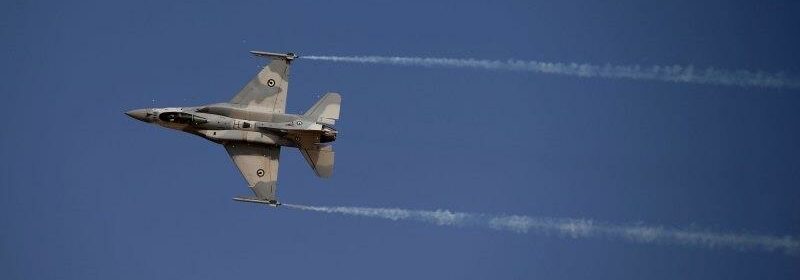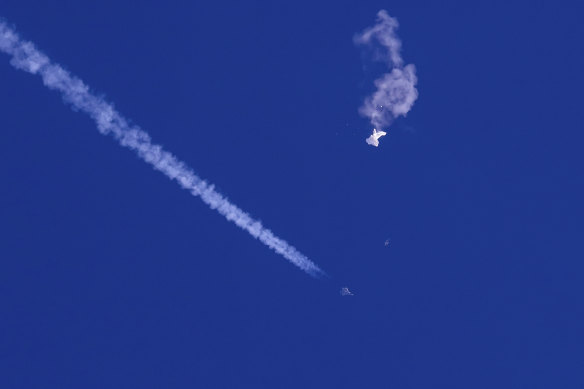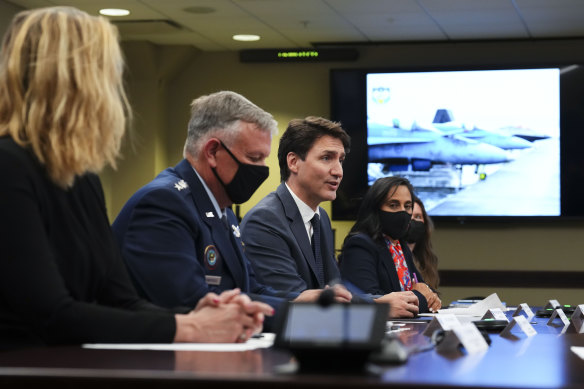‘We’re calling them objects, not balloons, for a reason’

Washington: Another day, another unidentified flying object shot down in the USA.
One week after a suspected Chinese spy balloon was taken down off the coast of South Carolina, a fourth object has been dismantled across the skies of North America, fuelling speculation, fears and conspiracy theories in a country already on edge over perceived threats by Beijing.
The US recently shot down a Chinese spy balloon above the Atlantic Ocean.Credit:AP
The latest downing took place on Sunday (Monday AEDT) over Lake Huron in Michigan near the Canadian border. As the nation’s attention was turned towards the Super Bowl, a US F-16 fighter jet shot down an unidentified object that was shaped like an octagon and flying at an altitude of 20,000 feet (6100 metres) – at least 10,000 feet lower than an everyday aircraft.
Pentagon officials said the object did not pose a military threat, but “its path and altitude raised concerns, including that it could be a hazard to civil aviation”.
A similar reason was given on Friday when the US military shot an object roughly the size of a small car over the coast of Alaska “out of an abundance of caution”. It also posed a threat to civilian air traffic by operating an altitude of 40,000 feet.
On Saturday, a US fighter jet shot was down an unidentified, cylindrical shaped object that was flying at a similar altitude over Canadian skies in central Yukon, about 160 kilometres from the border.
The succession of shoot-downs has alarmed some Americans, ignited concerns about the safety of the continent’s airspace and prompted endless theories about what kind of objects are floating in the skies and who exactly has sent them. Were the latest objects acts of subterfuge? A weather balloon gone rogue? An effort by China, Russia or some other adversary to test American defences?
Except for the Chinese spy balloon last week, the fact is we simply don’t know yet, which is part of the problem. In an information vacuum, all sorts of theories can emerge.
Indeed, when asked during a briefing on Sunday whether he could rule out the prospect of aliens or extraterrestrials, US Air Force General Glen VanHerck replied: “I haven’t ruled out anything at this point. We continue to assess every threat or potential threat unknown that approaches America, with an attempt to identify it”.
What we do know, however, is this. Firstly, after the political uproar over the “Balloongate” scandal, the North American Aerospace Defence Command (NORAD) – whose job it is to track and identify potential threats across the continental United States and Canada – has changed its detection capabilities so that it can identify more potential threats.
As a result, NORAD is seeing more objects in the sky and taking them down if they are unmanned, threatening commercial aviation, and if it’s safe to do so.
“We’re calling them objects, not balloons, for a reason,” said VanHerck who heads NORAD.
(An unanswered question is whether there are actually more objects coming into airspace now, or if the adjustments are allowing the government to simply detect them at a much higher rate).
Secondly, the sighting of unidentified flying objects are not uncommon in the US. A government report released last month found that the Pentagon’s new office for investigating potential sightings had received 366 new reports of UFOs – known in the Pentagon as “unidentified aerial phenomena” – since March 2021.
Canadian Prime Minister Justin Trudeau, centre, and Minister of National Defence Anita Anand, second right, join General Glen VanHerck, second left, Commander of US Northern Command and NORAD, take part in a briefing last year.Credit:The canadian Press/AP
According to the report, 163 of those sightings were preliminarily identified as “balloon or balloon-entities”. A handful of other reports have been attributed to drones, birds, weather events or airborne debris like plastic bags.
And thirdly, President Joe Biden has a political problem. There seems to be little doubt that China violated US airspace and sovereignty last week to spy on some of the most sensitive military bases in the country. And the White House, quite rightly, has come under sustained attack – and questions – for not taking the balloon down sooner.
In the context of broader US concerns about China’s influence – which encompasses everything from TikTok, Beijing’s role in illicit fentanyl flooding America, and economic coercion in the Indo-Pacific – tensions in Washington’s newly divided Congress are off the charts.
“Domestic politics is dominating the US response and heightened concern about our homeland security, so I really hope that the US, in a very short period of time, is able to collect enough information, analyse it, and tell the American public what’s going on,” said China-relations expert Bonnie Glaser, the director of the Asia Program at the German Marshall Fund.
Glaser she did not believe Chinese President Xi Jinping wanted a crisis with the US over this matter, noting Beijing’s early attempt to defuse the situation. She also compared it to the genuine crisis that took place in the skies in 2001, when an American jet plane collided with a Chinese jet fighter, killing the Chinese pilot and forcing and American plane to land at Hainan island where authorities took the crew into custody for 11 days until the US expressed regret for what had happened.
Nonetheless, the Biden administration has made no progress in expanding cooperation with China, she said. Meanwhile, the Chinese have not even been willing to accept that the US-China relationship is dominated by competition.
“So we have a long way to go before we make real progress,” Glaser warned. “And this balloon episode is just going to make that all the more difficult.”
Get a note directly from our foreign correspondents on what’s making headlines around the world. Sign up for the weekly What in the World newsletter here.
Most Viewed in World
From our partners
Source: Read Full Article

